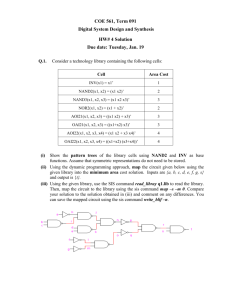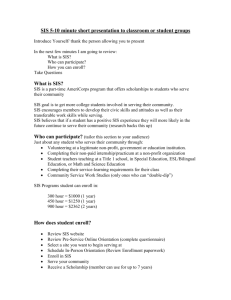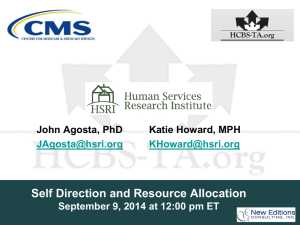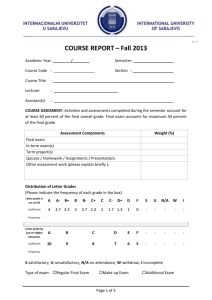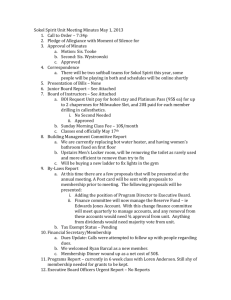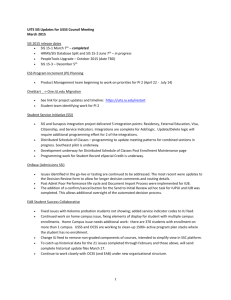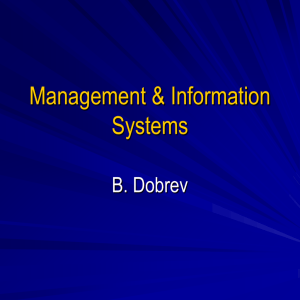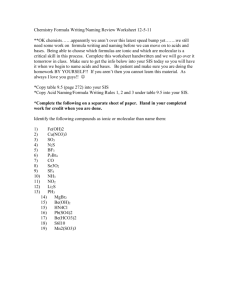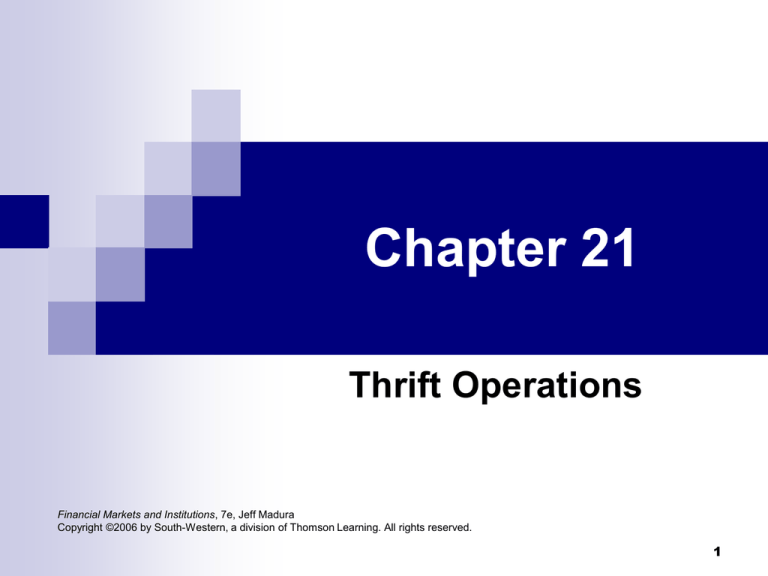
Chapter 21
Thrift Operations
Financial Markets and Institutions, 7e, Jeff Madura
Copyright ©2006 by South-Western, a division of Thomson Learning. All rights reserved.
1
Chapter Outline
Background on savings institutions
Sources and uses of funds
Exposure to risk
Management of interest rate risk
Valuation of a savings institution
Interaction with other financial institutions
2
Chapter Outline (cont’d)
Participation in financial markets
Performance of savings institutions
Savings institution crisis
Background on credit unions
Sources and uses of credit union funds
Credit union exposure to risk
Regulation of credit unions
3
Background on Savings Institutions
Savings institutions include savings banks and
S&Ls
S&Ls
are the most dominant type
Savings institutions are mainly concentrated in the
Northeast
The insuring agency for S&Ls is the Savings
Association Insurance Fund (SAIF)
The insuring agency for savings banks is the Bank
Insurance Fund (BIF)
Both agencies are administered by the FDIC
Savings
banks and S&Ls are very similar in their
sources and uses of funds
4
Background on Savings Institutions
(cont’d)
2%
20%
78%
More than $1
billion
Between $100
million and $1
billion
Less than $100
million
5
Background on Savings Institutions
(cont’d)
Ownership
Most
SIs are mutual (owned by depositors)
Many SIs have shifted their ownership structure from
depositors to shareholders through mutual-to-stockconversions
Allow SIs to obtain additional capital by issuing stock
Provide owners with greater potential to benefit from
performance
Make SIs more susceptible to hostile takeovers
6
Background on Savings Institutions
(cont’d)
Ownership (cont’d)
In
an acquisition, both SIs have to be stock-owned
Merger-conversion
The
number of SIs today is about one-half of the
number in 1994
The total assets of stock SIs has increased by more
than 60 percent since 1994
The total assets of mutual SIs has remained steady
since 1994
7
Background on Savings Institutions
(cont’d)
Regulation of savings institutions
Regulated at both the state and federal level
Federally chartered SIs are regulated by the Office of Thrift
Supervision (OTS)
State-chartered SIs are regulated by the state that has
chartered them
Regulatory assessment of SIs
Regulators conduct periodic onsite examinations of capital and risk
Monitoring is conducted using the CAMELS rating
Deregulation of services
Recently, SIs have been granted more flexibility to diversify
products
8
Sources of Funds (cont’d)
Borrowed funds
SIs can borrow from other depository institutions in the federal
funds market
SIs can borrow at the Fed’s discount window
SIs can borrow through repos
Capital
The capital (net worth) of SIs is composed of retained earnings
and funds obtained from issuing stock
SIs are required to maintain a minimum level of capital
9
Uses of Funds
Cash
SIs
maintain cash to satisfy reserve requirements
and accommodate withdrawal requests
Mortgages:
Are
the primary asset of SIs
Typically have long-term maturities and can be
prepaid by borrowers
Are mostly for homes or multifamily dwellings
Are subject to interest rate risk and default risk
10
Uses of Funds (cont’d)
Mortgage-backed securities
SIs
issue securities backed by mortgages
Cash flows to holders of these securities may not be
steady because of prepayment
Other securities
All
SIs invest insecurities such as Treasury bonds
and corporate bonds
Provide liquidity
Some
thrifts invested in junk bonds prior to 1989
11
Uses of Funds (cont’d)
Single-Family
Mortgages
Multifamily
Morgages
Other Mortgages
11%
12%
Commercial Loans
50%
8%
Mortgage-Backed
Securities
Other Securities
6%
4%
4%
Consumer Loans
5%
Other Assets
12
Exposure to Risk
Liquidity risk
SIs commonly use short-term liabilities to finance long-term
assets
If new deposits are not sufficient to cover withdrawal requests,
SIs can experience liquidity problems
SIs can obtain temporary funds through repurchase agreements
or in the federal funds market
Credit risk
Conventional mortgages are the primary source of credit risk
SIs often carry the risk rather than paying for insurance
Many SIs were adversely affected by the weak economy in
2001–2002
13
Exposure to Risk (cont’d)
Interest rate risk
Many
SIs were hurt by rising interest rates in the
1980s because of their heavy concentration on fixedrate mortgages
Many SIs benefited from their exposure to interest
rate risk in the 2001–2002 period when interest rates
declined
14
Management of Interest Rate Risk
(cont’d)
Conclusions about interest rate risk
Although
strategies are useful, it is virtually
impossible to completely eliminate interest rate risk
Mortgages may be prepaid
15
Valuation of a Savings Institution
The value should change in response to
changes in its expected cash flows and to
changes in the required rate of return:
V f E (CF ), k
-
16
Valuation of a Savings Institution
(cont’d)
Factors that affect cash flows
E (CF ) f ( ECON, Rf , INDUS, MANAB)
Change
-
?
in economic growth
During periods of strong economic growth:
Consumer loan and mortgage loan demand is higher
Loan defaults are reduced
17
Valuation of a Savings Institution
(cont’d)
Factors that affect cash flows (cont’d)
Change
SIs’ cash flows are inversely related to interest rate
movements
SIs rely heavily on short-term deposits
SIs’ assets commonly have fixed rates
Change
in the risk-free interest rate
in industry conditions
SIs are exposed to regulatory constraints, technology, and
competition
18
Valuation of a Savings Institution
(cont’d)
Factors that affect cash flows (cont’d)
Change
in management abilities
Managers can attempt to make internal decisions
that will capitalize on the external forces that the
bank cannot control
Skillful managers will recognize how to revise the
composition of the SI’s assets and liabilities to
capitalize on existing economic or regulatory
conditions
19
Valuation of a Savings Institution
(cont’d)
Factors that affect the required rate of
return by investors
k f ( Rf , RP )
Change in the risk-free rate
When the risk-free rate increases, so does the return
required by investors:
Rf f ( INF, ECON, MS, DEF )
-
20
Valuation of a Savings Institution
(cont’d)
Factors that affect the required rate of
return by investors (cont’d)
Change
in the risk premium
When the risk premium increases, so does the return
required by investors:
RP f ( ECON, INDUS, MANAB)
?
-
21
Savings Institution Crisis (cont’d)
Reasons for failure (cont’d)
Losses
on loans and securities
Crisis was precipitated by unpaid loans
Major loan losses were in commercial real estate
SIs were forced to assume real estate holdings
that were sometimes worth less than half the loan
amount originally provided
Fraud
Most commonly, managers used depositors’ funds
for purchases of personal assets
22
Savings Institution Crisis (cont’d)
Reasons for failure (cont’d)
Illiquidity
SIs experienced a cash flow deficiency as a result
of loan losses
SIs were forced to offer higher interest rates on
deposits to attract more funds
The FSLIC was experiencing its own liquidity
problems, exacerbating the liquidity problem
23
Savings Institution Crisis (cont’d)
Impact of the bailout
Stronger
Many SIs are now required to maintain a higher
minimum level of capital
Higher
asset quality
SIs have been forced to maintain more
conservative asset portfolios
More
capital positions
consolidation
FIRREA allows commercial banks and other
institutions to purchase failing or healthy SIs
24
Background on Credit Unions
Credit unions are nonprofit organizations
composed of members with a common
bond
e.g.,
labor union, church, university
CUs accept deposits from members and
channel funds to those members who
want to finance the purchase of assets
25
Background on Credit Unions
(cont’d)
Ownership of credit unions
CUs
are technically owned by depositors
Deposits are called shares, which pay
dividends
CUs’ income is not taxed
CUs can be federally or state chartered
Federal CUs are growing at a faster rate
Most
CUs are very small
26
Background on Credit Unions
(cont’d)
Advantages and disadvantages of credit unions
Can
offer attractive rates to their members
Noninterest expenses are relatively low because
much of their assets is donated
Volunteer labor may not have the incentive to manage
operations efficiently
Common bond requirements restrict a given CU’s
growth
Many CUs are unable to diversify geographically
CUs have increasingly been merging
27
Sources and Uses of Credit Union
Funds
Sources of funds
Mostly from share deposits by members
Either share deposits, share certificates, or share drafts
For temporary funds, CUs can borrow from other CUs
or from the Central Liquidity Facility (CLF)
Acts as a lender similar to the Fed’s discount window
CUs
maintain capital, primarily in the form of retained
earnings
Uses of funds
The majority of funds is used for loans to members
Some CUs offer long-term mortgage loans
CUs purchase government and agency securities
28
Credit Union Exposure to Risk
Liquidity risk
CUs
can experience liquidity problems when an
unanticipated wave of withdrawal occurs without an
offsetting amount of new deposits
Credit risk
CUs
concentrate on personal loans to members
Most loans are secured
CUs with very lenient loan policies could experience
losses
29
Credit Union Exposure to Risk
(cont’d)
Interest rate risk
Maturities
on consumer loans are short term,
causing assets to be rate sensitive
Movements in interest revenues and interest
expenses are highly correlated
The spread between interest revenues and
interest expenses remains stable over time
30

